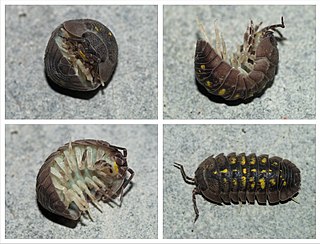
Isopoda is an order of crustaceans. Members of this group are called isopods and include both aquatic species, and terrestrial species such as woodlice. All have rigid, segmented exoskeletons, two pairs of antennae, seven pairs of jointed limbs on the thorax, and five pairs of branching appendages on the abdomen that are used in respiration. Females brood their young in a pouch under their thorax called the marsupium.

Armadillidiidae is a family of woodlice, a terrestrial crustacean group in the order Isopoda. Unlike members of some other woodlice families, members of this family can roll into a ball, an ability they share with the outwardly similar but unrelated pill millipedes and other animals. This ability gives woodlice in this family their common names of pill bugs or roly polies. Other common names include slaters, potato bugs, butchy boys, and doodle bugs. Most species are native to the Mediterranean Basin, while a few species have wider European distributions. The best-known species, Armadillidium vulgare, was introduced to New England in the early 19th century and has become widespread throughout North America.

Armadillidium vulgare, the common pill-bug, potato bug, common pill woodlouse, roly-poly, slater, doodle bug, or carpenter, is a widespread European species of woodlouse. It is the most extensively investigated terrestrial isopod species. It is native to Mediterranean Europe, but as an introduced species they have become naturalized in almost all suitable ecosystems. They are kept as pets by hobbyists for their wide range of possible color variations.

Woodlice are terrestrial isopods in the suborder Oniscidea. Their name is derived from being often found in old wood, and from louse, a parasitic insect, although woodlice are neither parasitic nor insects.

Armadillidium klugii is a lesser-known, rare Balkan, Dalmatia-based species of woodlouse, most distinguished by its colouration which resembles the red markings of the Mediterranean black widow Latrodectus tredecimguttatus. This is probably a kind of mimicry, to ward off predators that mistake the harmless animal for a venomous spider.

Armadillidium atticum is a European species of woodlouse endemic to Greece. It is a relatively small species and belongs to the so called "Armadillidium insulanum complex".

Armadillidium sfenthourakisi is a European species of woodlouse endemic to Greece.

Armadillidium maniatum is a European species of woodlouse endemic to Greece.

Armadillidium petralonense is a European species of woodlouse endemic to Greece. It is a relatively medium-sized species that probably belongs to the so-called "Armadillidium fossuligerum complex".

Armadillidium pieperi is a European species of woodlouse endemic to Greece. It is a relatively medium-sized species that probably belongs to the so-called "Armadillidium fossuligerum complex".

Armadillidium jerrentrupi is a European species of woodlouse endemic to Greece. It is a relatively medium-sized species that probably belongs to the so-called "Armadillidium fossuligerum complex".

Armadillidium teramense is a European species of woodlouse endemic to Italy. It belongs to the "Orthotrigoniae" section of the genus and is currently known only from the type series.

Armadillidium phalacronum is a European species of woodlouse endemic to Greece. It is a relatively small-sized species that probably belongs to the so-called "Armadillidium insulanum complex".

Armadillidium stymphalicum is a European species of woodlouse endemic to Greece.

Armadillidium maculatum, also known as the zebra isopod or zebra pillbug is an Armadillidium species of woodlouse, named for its black and white patterns. It is native to southern France. It is quite popular as pets or vivarium cleaners, due to their ability to break down various waste.

Eluma is a genus of woodlice in the family Armadillidiidae. The members of this genus are native to the Iberian Peninsula, Morocco, the Atlantic islands of the Azores, Canaries and Madeira, and from the west of France to the British Isles.

Armadillidium album, also known as the beach pill woodlouse, is a species of isopod within the family Armadillidiidae. The species is salt tolerant, inhabiting coastal sand dunes and saltmarshes within Europe. They can sometimes be found under driftwood or burrowed within grains of sand of which their colour pattern mimics.
Eluma matae is a species of woodlouse distributed throughout Portugal.
Eluma praticola is a species of woodlouse, found throughout northeastern Morocco in the Oued Laou basin. Its name derives from the Latin word for meadow (pratum) and the stem of the Latin word for live (colere).

















